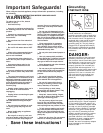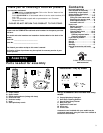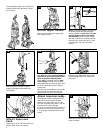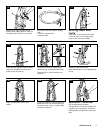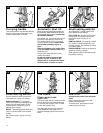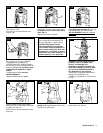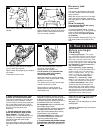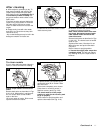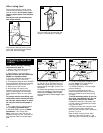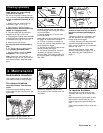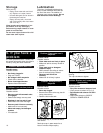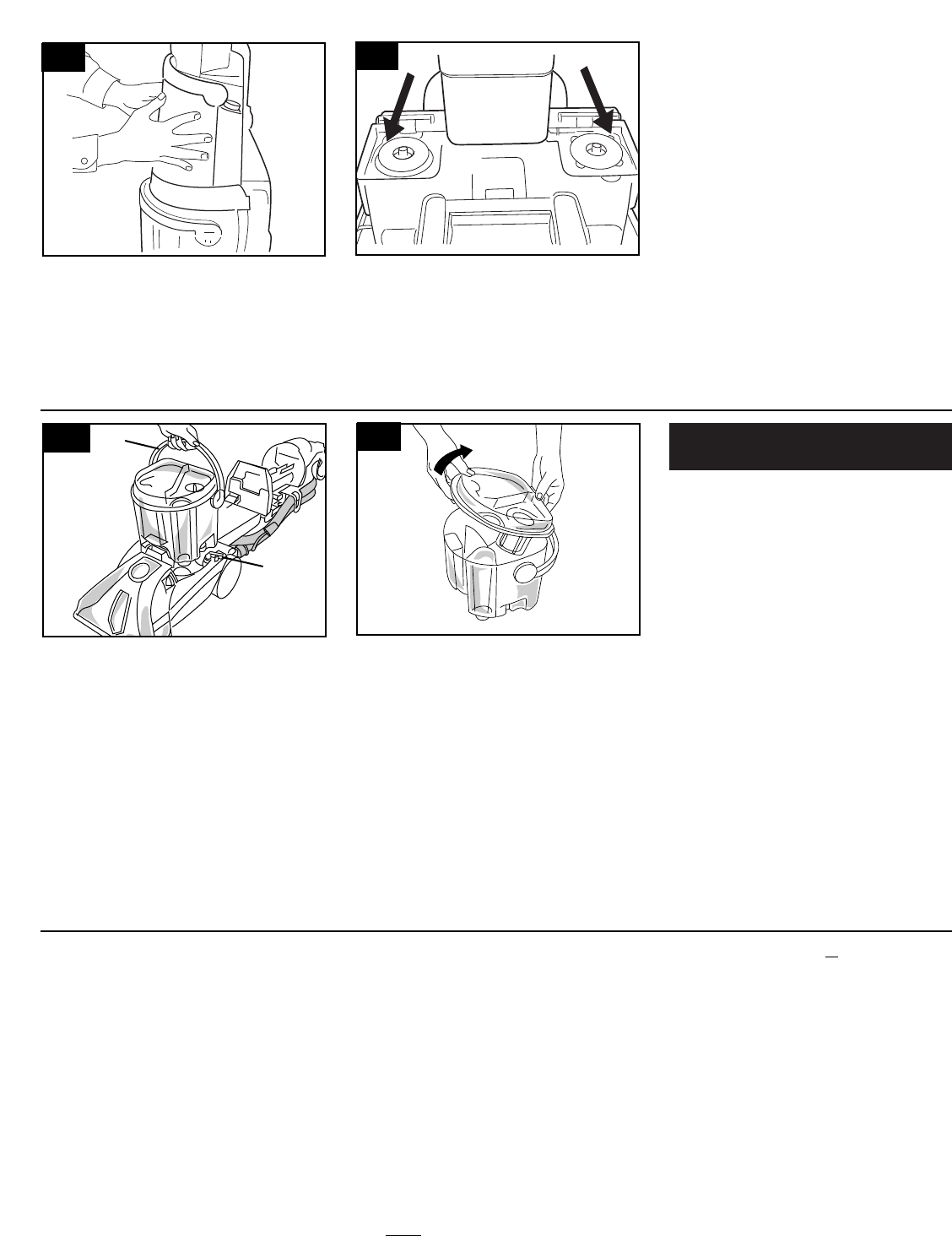
Before you begin
cleaning
a. Vacuum thoroughly - For carpet,
use a HOOVER vacuum cleaner with an
agitator for best results. Vacuum uphol-
stery with a vacuum cleaner with clean-
ing tool attachments. Use a crevice tool
to reach into tufts and folds. Do not use
the SteamVac™ carpet cleaner as a
dry vacuum cleaner.
b. For upholstery, check cleaning
code - Use your HOOVER SteamVac™
carpet cleaner only if the upholstery
fabric is marked with a “W” (for “wet”
clean) or “S/W” (for “solvent/dry” or
“wet” clean). Do not clean fabric
marked “S” (“solvent/dry” clean
only). If your upholstery does not have
a code, seek professional assistance.
c. Test for colorfastness - Wet a white
absorbent cloth with the detergent. In a
small, hidden area, gently rub the surface
with the dampened cloth. Wait ten minutes
and check for color removal or bleed with
white paper towel or cloth. If surface has
more than one color, check all colors.
3. How to clean
d. When cleaning entire floor, move
furniture out of area to be cleaned
(may not be necessary if only high traf-
fic areas are to be cleaned). For furni-
ture too heavy to move, place aluminum
foil or wax paper under legs. This will
prevent wood finishes from staining car-
pet. Pin up furniture skirts and
draperies.
e. Pretreat spots and heavy traffic
areas with HOOVER
® Spot & Stain
Spray Cleaner*- Test Spot & Stain
Spray Cleaner for colorfastness by first
spraying it on a hidden area; wait ten
minutes and blot with white paper
towels or cloth.
If no color change is visible, spray Spot &
Stain Spray Cleaner onto spots and traffic
areas. Wait at least ten minutes. Use your
SteamVac™ carpet cleaner to pick up Spot
& Stain Spray Cleaner and spot. Repeat
until spot is removed; carefully scrub with a
household scrub brush if necessary.
Do not saturate carpet or upholstery with
Spot & Stain Spray Cleaner.
No cleaning solution removes all stains from
all carpets. Stain removal varies with the
type of spill, time elapsed before removal,
carpet material, and carpet type.
f. To prevent staining, use plastic or alu-
minum foil to protect wood or metal sur-
faces from possible water spray.
g. To avoid wetting and possible damage
to wood floors underneath area rugs/car-
pet, either
move area rugs/ carpet to a non-
wood bare floor surface or
place waterproof
material (e.g. plastic) underneath them
before cleaning.
See pages 12-15 for instructions on various
cleaning tasks.
*Available at additional cost if not included
with your model.
2-21
Recovery tank
(lower tank)
The recovery tank holds the dirty solu-
tion that is picked up from the surface
being cleaned.
When the recovery tank is full, the auto-
matic shut-off will engage, suction will
stop (see page 8), and the tank must be
emptied.
How to empty
Turn carpet cleaner off and unplug
from electrical outlet.
To prevent possible leaking, remove
clean water tank (Fig. 2-10) by pressing
down on tank handle and pulling for-
ward; set tank aside (do not set tank
on furniture).
Step on handle release pedal (Fig. 2-3)
and lower handle until it rests on the
floor.
Turn recovery tank latches (A) outward
(one on each side of tank).
Raise handle (B) straight up and lift tank
off cleaner.
Carry tank to sink or drain.
2-22
Lower handle toward back of tank to
unlock lid. Lift lid off tank.
Empty tank and reposition lid.
For full suction, it is important that
the recovery tank lid is properly
secured before cleaning.
Raise tank handle to carrying position
and place it onto carpet cleaner. Lower
handle to front of tank.
Turn latches (one on each side of tank)
inward to lock tank in place.
Raise handle of carpet cleaner to
upright position and reposition upper
clean water tank.
A
B
2-19
Check tank to make sure it is securely
latched.
2-20
NOTE: There may be a small amount of
water (indicated by arrows) on the base
when the tank is removed from the unit.
This is a normal condition.
10



